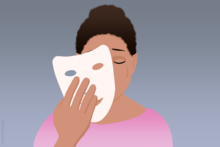Masking (personality)

Masking is a process by which an individual changes or "masks" their natural personality to conform to social pressures, abuse or harassment. Some examples of masking are a single overly dominant temperament, or humor, two incongruent temperaments, or displaying three of the four main temperaments within the same individual. Masking can be strongly influenced by environmental factors such as authoritarian parents, rejection, and emotional, physical, or sexual abuse. An individual may not even know they are masking because it is a behavior that can take many forms.
Masking should not be confused with masking behavior, which is to mentally block feelings of suffering as a survival mechanism.
History[]

The term masking was first used to describe the act of concealing disgust by Ekman (1972) and Friesen (1969).[1] It was also thought of as a learned behavior. Developmental studies have shown that this ability begins as early as preschool and improves with age.[2] In recent developmental studies, masking has evolved and is now defined as concealing one's emotion by portraying another emotion. It is mostly used to conceal a negative emotion (usually sadness, frustration, and anger) with a positive emotion.[1]
Causes[]
Contextual factors including relationships with one's conversation partner, status differences, location, and social setting are all reasons as to why an individual would express, suppress, or mask an emotion.[1] Masking is a facade to behave in certain ways that would help one hide their emotions and represses emotions that are not approved by those around them. Because a person wants to receive acceptance from the public, masking helps disguise characteristics like anger, jealousy or rage - emotions that would not be considered socially acceptable.[3][medical citation needed]
Situations[]
- Personal space: Varies with individuals could be masking emotions to those close to them or strangers.
- Setting
Gender differences[]
Masking negative emotions differ for each gender. Females tend to have an advanced ability when hiding their negative emotions towards something they dislike as compared to males.[4] One of the possible reasons as to why females are able to mask their negative emotions better is society's pressure that a girl must act nice.[4]
Ethnicity[]
Masking also differs between cultures. Some studies state that certain cultures tend to moderate their expressions of emotion while others show a greater amount of positive emotions and expressions.[1]
Autistic masking[]
Some autistic people have been described as being able to "mask" or "camouflage" their signs of autism in order to meet social expectations. This may involve behavior such as suppressing self-calming repetitive movements, faking a smile in an environment that they find uncomfortable or distressing, consciously evaluating their own behavior and mirroring others, or choosing not to talk about their interests. As masking is often a conscious effort, it can be exhausting for autistic people to do this for an extended period of time (socially, but also in work contexts). In addition to making the person appear non-autistic or neurotypical, masking may conceal the person's need for support.[5] Such autistic people have cited social acceptance; the need to get a job, avoiding ostracism, or avoiding verbal or physical abuse as reasons for masking.[5]
Research has found that autistic masking is correlated with depression and suicide.[6][7] Many autistic adults in one survey described profound exhaustion from trying to pretend to be non-autistic.[8] Therapies that teach autistic people to mask, such as some forms of applied behavior analysis, are controversial.[9]
Signs and symptoms[]
This section needs more medical references for verification or relies too heavily on primary sources. (April 2021) |
Each person masks their emotions differently. During one's childhood, an individual learns to behave a certain way when they receive approval from those around them and thus develops a mask. The individual is "not conscious of the role they've adopted and is projecting outwards to people they meet".[10] In some cases where the individual is highly conscious, they may not know that they are wearing a mask. Wearing a mask takes away energy from a person's consciousness and, in the long run, wears out their energy.[10]
Masking tendencies can be more obvious when a person is sick or weak, since they may no longer have the energy to maintain the mask.
Consequences[]
Little is known about the effects of masking one's negative emotions. In the workplace, masking leads to feelings of dissonance, insincerity, job dissatisfaction, emotional and physical exhaustion, and self-reported health problems.[11] Some have also reported experiencing somatic symptoms and harmful physiological and cognitive effects as a consequence.[1]
Masked emotions[]
Emotions that are usually concealed:
Emotions that are expressed in place of the concealed emotions:
See also[]
- Alter ego
- Beard (companion)
- Closet Jew
- Closeted
- Defense mechanism
- Dramaturgy (sociology)
- Facial Action Coding System
- Identity formation
- Minority stress
- Model minority
- Passing (sociology)
- Persona (psychology)
- Shibboleth
- Stigma management
- Undercover
References[]
- ^ Jump up to: a b c d e De Gere, Dawn (2008). "The face of masking: Examining central tendencies and between-person variability in display management and display rule". ProQuest Dissertations and Theses.
- ^ Cole, Pamela (Dec 1986). "Children's Spontaneous Control of Facial Expression". Child Development. 57 (6): 1309–1321. doi:10.1111/j.1467-8624.1986.tb00459.x.
- ^ Malchiodi, Cathy. "The Healing Arts". Psychology Today.
- ^ Jump up to: a b Davis, Teresa (1995). "Gender Differences in Masking Negative Emotions: Ability or Motivation?". Developmental Psychology. 31 (4): 660–667. doi:10.1037/0012-1649.31.4.660.
- ^ Jump up to: a b Haelle, Tara (2018). "The Consequences of Compensation in Autism". Neurology Advisor.
- ^ Cage, Eilidh (2017). "Experiences of Autism Acceptance and Mental Health in Autistic Adults". Journal of Autism and Developmental Disorders. 49 (2): 473–484. doi:10.1007/s10803-017-3342-7. PMC 5807490. PMID 29071566.
- ^ Cassidy, Sarah; Bradley, Louise; Shaw, Rebecca; Baron-Cohen, Simon (2018). "Risk markers for suicidality in autistic adults". Molecular Autism. 9: 42. doi:10.1186/s13229-018-0226-4. PMC 6069847. PMID 30083306.
- ^ Russo, Francine. "The Costs of Camouflaging Autism". Spectrum News.
- ^ DeVita-Raeburn, Elizabeth (August 11, 2016). "Is the Most Common Therapy for Autism Cruel?". The Atlantic.
- ^ Jump up to: a b Kundalini, Betsy. "Article: The Mask of the Personality".
- ^ Fisher, Cynthia; Neal Ashkanasy (2000). "The Emerging Role of Emotions in Work Life: An introduction" (PDF). Journal of Organizational Behavior. 21 (2): 123–129. doi:10.1002/(SICI)1099-1379(200003)21:2<123::AID-JOB33>3.0.CO;2-8.
- Hall, Karyn (2012). "Wearing Masks". Psych Central. Retrieved March 1, 2018.
- Hanson, Rick (March 17, 2011). "Who Is Behind the Mask". Psychology Today. Retrieved March 1, 2018.
+ Sparks, Susan (Oct 20, 2015). "The Masks That We Wear". Psychology Today. Retrieved March 1, 2018.
- Andrews, Victoria; et al. (2011). "No Evidence for Subliminal Affective Priming with Emotional Facial Expression Primes". Motivation and Emotion. 35 (1): 33–43. doi:10.1007/s11031-010-9196-3. S2CID 142863112.
- Underwood, Marion K. (1997). "Peer Social Status and Children's Understanding of the Expression and Control of Positive and Negative Emotions". Merrill - Palmer Quarterly. 43 (4): 610–34. ProQuest 1428979275.
- Hemmesch, Amanda R. (2011). "The Stigmatizing Effects of Facial Masking and Abnormal Bodily Movement on Older Adults' First Impressions of Individuals with Parkinson's Disease". Brandeis University. ProQuest 1428979275.
External links[]
- Personality
- Psychology